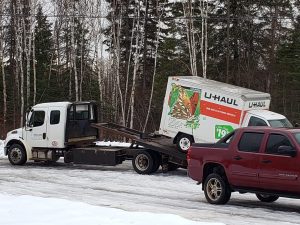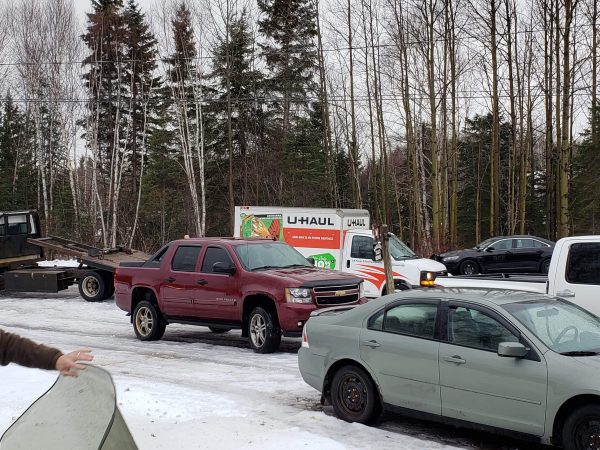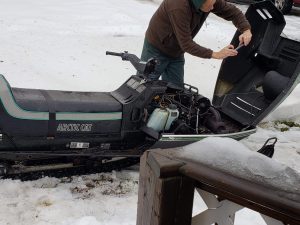
file photo – U-Haul being removed from Government Road in Wawa that had been involved in this incident.
On November 25, 2019, the Ontario Provincial Police (OPP) received a 911 call reporting that the driver of a U-Haul truck had filled up at a gas station on Highway 17 in White River and left without paying. An officer who was in the area spotted the truck and initiated a brief pursuit, which was terminated soon after. At some point, the U-Haul truck became involved in a collision. The occupants abandoned the truck and fled on a snowmobile. Shortly thereafter, the snowmobile crashed, resulting in serious injuries to a 29-year-old man. The Director of the Special Investigations Unit, Joseph Martino, has determined there is no basis for proceeding with charges against an OPP officer, and the file is closed.
SIU Director’s Report – Case # 19-PVI-284
Mandate of the SIU
The Special Investigations Unit is a civilian law enforcement agency that investigates incidents involving police officers where there has been death, serious injury or allegations of sexual assault. The Unit’s jurisdiction covers more than 50 municipal, regional and provincial police services across Ontario.
Under the Police Services Act, the Director of the SIU must determine based on the evidence gathered in an investigation whether an officer has committed a criminal offence in connection with the incident under investigation. If, after an investigation, there are reasonable grounds to believe that an offence was committed, the Director has the authority to lay a criminal charge against the officer. Alternatively, in all cases where no reasonable grounds exist, the Director does not lay criminal charges but files a report with the Attorney General communicating the results of an investigation.
Information Restrictions
Freedom of Information and Protection of Personal Privacy Act (“FIPPA”)
Pursuant to section 14 of FIPPA (i.e., law enforcement), certain information may not be included in this report. This information may include, but is not limited to, the following:
- Confidential investigative techniques and procedures used by law enforcement agencies; and
- Information whose release could reasonably be expected to interfere with a law enforcement matter or an investigation undertaken with a view to a law enforcement proceeding.
Pursuant to section 21 of FIPPA (i.e., personal privacy), protected personal information is not included in this document. This information may include, but is not limited to, the following:
- Subject Officer name(s);
- Witness Officer name(s);
- Civilian Witness name(s);
- Location information;
- Witness statements and evidence gathered in the course of the investigation provided to the SIU in confidence; and
- Other identifiers which are likely to reveal personal information about individuals involved in the investigation.
Personal Health Information Protection Act, 2004 (“PHIPA”)
Pursuant to PHIPA, any information related to the personal health of identifiable individuals is not included.
Other proceedings, processes, and investigations
Information may have also been excluded from this report because its release could undermine the integrity of other proceedings involving the same incident, such as criminal proceedings, coroner’s inquests, other public proceedings and/or other law enforcement investigations.
Mandate Engaged
The Unit’s investigative jurisdiction is limited to those incidents where there is a serious injury (including sexual assault allegations) or death in cases involving the police.
“Serious injuries” shall include those that are likely to interfere with the health or comfort of the victim and are more than merely transient or trifling in nature and will include serious injury resulting from sexual assault. “Serious Injury” shall initially be presumed when the victim is admitted to hospital, suffers a fracture to a limb, rib or vertebrae or to the skull, suffers burns to a major portion of the body or loses any portion of the body or suffers loss of vision or hearing, or alleges sexual assault. Where a prolonged delay is likely before the seriousness of the injury can be assessed, the Unit should be notified so that it can monitor the situation and decide on the extent of its involvement.
This report relates to the SIU’s investigation into the injuries that a 29-year-old man (the “Complainant”) suffered.
The Investigation
Notification of the SIU
On November 25, 2019, at 4:13 p.m., the Ontario Provincial Police (OPP) reported an injury that occurred earlier that day.
The OPP reported that at 12:38 p.m., police officers responded to a call regarding the theft of fuel. At 1:11 p.m., a police officer driving east on Highway 17 saw a vehicle believed to be the suspect vehicle. The police officer attempted to stop the vehicle, but a pursuit was terminated by the communications centre.
Sometime later, another police officer deployed a tire deflation device to try to stop the vehicle, but it drove around it and ended up driving off the roadway and into a snowbank.
Before a police officer arrived at the vehicle, he saw a snowmobile driving toward him with two occupants not wearing helmets. The police officer decided to stop the snowmobile to ask the riders if they had seen the suspect vehicle, but they sped away.
At 1:43 p.m., a police officer came across the snowmobile at the side of the road, with one of the riders, identified as the Complainant, having blood on his head. The Complainant was taken into custody, but the other rider fled.
The Complainant was taken to Lady Dunn Health Centre and admitted.
The OPP reported that no scene was held, the snowmobile was returned to the owner, and photographs would be taken of the scene and the U-Haul truck.
The notification was initially deemed not to invoke the SIU’s jurisdiction and the matter was closed.
On November 26, 2019, the OPP further reported that the Complainant had been diagnosed with a fractured orbital bone.
The Team
Number of SIU Investigators assigned: 4
Complainants
Complainant 29-year-old male interviewed, medical records obtained and reviewed
Civilian Witnesses
CW Interviewed
Witness Officers
WO #1 Interviewed
WO #2 Not interviewed, but notes received and reviewed
Subject Officers
SO Declined to be interviewed, as is the subject officer’s legal right, but submitted notes that were reviewed
Evidence
The Scene
At the time of notification, OPP advised that the scene, at the intersection of Magpie Road and Mission Road in Wawa, had not been secured and the involved snowmobile had already been returned to the owner.
Despite what some evidence suggests, the snowmobile was undamaged and was returned to the registered owner.
Communications Recordings
WO #2 was initially notified of the theft of gas by phone call. He was then notified of the pursuit.
After the SO reported the vehicle was not stopping for the SO and had accelerated to 120 km/h while the SO’s lights and siren were activated, the dispatcher reported the communications supervisor was monitoring the incident. WO #2 then directed the SO to “discontinue pursuit and provide end mileage.” The SO complied.
WO #2 then told the SO, “Don’t try and catch up to the vehicle please.”
After WO #1 reported the vehicle took severe evasive action around the spike belt, WO #2 broadcast “All units, this is WO #2 of the PCC North Bay. I’m taking control of this and I will order all units to terminate the pursuit immediately. Deactivate your lights and sirens, pull over to the shoulder once it’s safe to do so, and provide your mileage and wait for further instructions.” Both the SO and WO #1 complied.
After reports of a vehicle driving erratically in Wawa, WO #1 reported two males drove past him on a snowmobile without helmets. WO #1 suspected it was the males from the U-Haul truck.
Shortly thereafter, the SO reported, “They’re just going by me now at max.” The SO then reported, “So it’s just one guy and he just wiped out.” The SO then reported she had one male in custody and asked for an ambulance.
In a call to WO #2, the SO said she was driving on Mission Road when she heard WO #1 report he was at the end of Government Road. The SO then saw the approaching snowmobile with the driver not wearing a helmet. After the snowmobile went by, the SO pulled into the convenience store parking lot. After that the snowmobile climbed a snowbank and fell to the roadway. The SO turned the cruiser around and activated the emergency lighting to get behind the snowmobile, as it was in the middle of the road with the operator lying near it. When the male, now known to be the Complainant, started trying to turn on the machine, the SO approached and told him he needed medical attention. The SO told WO #2 she did not tell him he was under arrest at the time, as he needed medical attention and needed to sit in the SO’s cruiser until the ambulance arrived.
911 Call Recordings
The initial 911 call regarding the theft of gasoline was reported at 12:36 p.m.
Starting at 1:39 p.m., two individuals, including a retired OPP police officer, called 911 reporting the U-Haul truck collision, theft of the snowmobile, and the snowmobile collision.
Materials obtained from Police Service
Upon request, the SIU obtained and reviewed the following materials and documents from the OPP:
- Arrest Report for this incident;
- General Occurrence Report for this incident;
- Notes of WO #1 and #2;
- Notes of SO;
- OPP Photo Brief (Large Document form); and
- Traffic Collision Report for this incident.
Materials obtained from Other Sources
Upon request, the SIU obtained and reviewed the following materials and documents from other sources:
- The Complainant’s medical records; and
- The Complainant’s ambulance records.
Incident Narrative
While the Complainant had no recollection of the events that led to his injuries, based on the statements of one civilian and one police witness, the notes prepared by the SO and the communications supervisor, the communications recordings, and the ambulance and medical records of the Complainant, the facts which follow were established.
At 12:36 p.m., the OPP received a 911 call reporting the theft of gasoline from a gas station in White River.
At 1:10 p.m., the SO spotted the truck driving southbound on Highway 17. She made a U-turn and activated her emergency equipment in an attempt to stop the truck. At 1:12 p.m., when the truck started to accelerate and appeared to be reaching speeds in excess of 120 km/h, the SO notified the communications centre and was immediately directed, by the communications supervisor, WO #2, to terminate the pursuit. The SO then slowed her vehicle and pulled over to the side of the road, observing the truck continuing to accelerate to speeds in excess of 130 km/h. Shortly thereafter, the SO was advised to continue at patrol speed and she again pulled onto the roadway.
WO #1 reported that he set up a spike belt on the roadway in order to attempt to stop the truck. When WO #1 reported, however, that the truck had driven around the belt, WO #2 directed all units to terminate immediately, to deactivate their lights and sirens, and to pull over to the shoulder when it was safe to do so.
Beginning at 1:39 p.m., two 911 calls were received by the OPP communications centre reporting first that the U-Haul had been involved in a collision, and then that a snowmobile had been stolen and been involved in further collisions. Evidence reveals that the CW and the Complainant, who were operating the snowmobile without helmets, caused it to roll on its side on three occasions.
WO #1 reported that he had observed two males, without helmets, drive past him on a snowmobile and that he suspected that these were the same two men whom he had seen in the U-Haul truck. WO #1 then flashed his emergency lights and stuck his arm out the driver window of his cruiser, to get the attention of the snowmobile operator, but the driver did not stop. WO #1 did not turn his vehicle around, nor did he pursue the snowmobile.
Evidence reveals that, following the snowmobile rolling on its side on the third occasion, the CW abandoned the snowmobile to continue on foot, while the Complainant righted the snowmobile and drove away.
Shortly thereafter, the SO reported that the snowmobile had just passed her on the roadway in Wawa, going in the opposite direction. While the SO pulled into a convenience store parking lot to turn around to follow the snowmobile, the snowmobile was observed to climb a snowbank, following which it again descended, crashing back onto the roadway, ejecting the driver, the Complainant, whose head made contact with the pavement. When the Complainant, who was obviously bleeding from the head area, tried to start the snowmobile up again, the SO approached him and told him that he required medical assistance, following which, at 1:45 p.m., an ambulance was requested, and the Complainant sat in the SO’s police cruiser awaiting its arrival.
Relevant Legislation
Section 320.13 (1), Criminal Code – Dangerous operation
Analysis and Director’s Decision
The Complainant was transported to hospital where he was diagnosed as having sustained a possible closed-head injury with significant concussion and a right orbital bone fracture.There is no allegation that any police officer, at any time, caused any injury to the Complainant.The only offence that arises for consideration in this case is that of dangerous driving contrary to section 320.13(1) of the Criminal Code. The offence is predicated, in part, on conduct that amounts to a marked departure from the level of care that a reasonable person would have exercised in the circumstances. I am satisfied that the manner in which the SO operated her police vehicle fell within the limits of care prescribed by the criminal law. While the SO did initially initiate a vehicular pursuit for a fairly minor offence, that being theft under $5000, it bears reiterating that the officer quickly reduced her speed after having travelled only about one kilometre, presumably on the basis that it was not in the public interest to continue and because the speed of the U-Haul truck was so great as to pose a danger. I note that the SO had already reduced her speed and disengaged her emergency lighting system and siren prior to the direction by WO #2 to do so, following which the SO pulled to the side of the road and called in her mileage. It should also be noted that there is no indication that the SO ever actually endangered, by the manner of her driving, any third-party motorists or pedestrians along Highway 17. Nor did the SO put undue pressure on the CW. In fact, the evidence indicates that the CW saw that the SO had almost immediately slowed and pulled over, allowing the CW every opportunity to reduce his speed and adopt a safer course. Instead, the CW continued to accelerate and drive in a manner that was reported as erratic, culminating in his crashing the U-Haul truck. It is clear that the SOhad abandoned any attempts to stop the U-Haul long before it crashed.Following the CW’s abandonment of the snowmobile, it is further clear that when the Complainant drove the snowmobile up the snowbank, before he lost control of the snowmobile and it crashed, no police officer was in pursuit or in any way involved with the snowmobile and therefore there is no causal connection between the injuries sustained by the Complainant and the actions of any police officer.
On the aforementioned record, I have no reasonable grounds to believe that the SO either caused or contributed to the collision in question, or otherwise drove dangerously in violation of the Criminal Code. Accordingly, there is no basis for proceeding with charges against the officer, and the file is closed.
Date: April 28, 2020
Electronically approved by
Joseph Martino
Director
Special Investigations Unit
- Michipicoten High School 70th Reunion Needs Your Registration - May 1, 2024
- Wednesday Morning News, May 1 - May 1, 2024
- Tuesday Morning News – April 30 - April 30, 2024
 Wawa-news.com You can't hear the 'big picture'!
Wawa-news.com You can't hear the 'big picture'!



